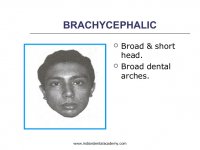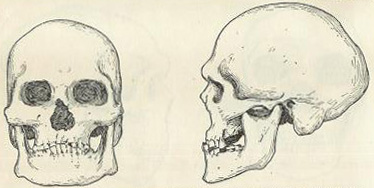Allways same old stories with incomplete doc -
It's evident Ötzi is not 'mesochephalic': he 's 'mesocrane' (over 75 Cranial Index) - but his skull is reasonably elongated whatever people say - on life it would have been qualified 'meso 'dolichocephalic', not mesocephalic (on life it began after IC 80)
That said I'm glad to see two views of Ötzi crania, even if not too precise (I would bet he was about IC 76)– Now I see better some ‘mediter’ aspects in his face spite he doesn’t seem too typical, but his jaw, yes, is more ‘mediter’ - his low skull is less evident, with a high placed occiput, something ‘cromagnoid’ ; surely a good example for meso-neolithic pops crossings in W-Europe, but the ‘mediter’ here doesn’t evocate the pedomorphic highskulled ‘danubian’ so common type among first agricultors of SE Europe and W Anatolia.
Brachycephaly (true : over 84 on cranium) begun roughly about the 8000 BC ?, with a future center around Bavaria/Switzerlands/Jura France (W Alps in sme way) – first brachy’s of Ofnet in Bavaria (one was IC 87) were found in company of dolicho’s more or less ‘brünnlike’ as a lot of Mesolithics but issued from Upper Paleo and also some sub-mesocephalic highskulled Azileans close to Teviec type; some details lead to the conclusion that all these skulls were not from an united cultural group. The brachy’s had big skulls, lowskulled, broad square faces and broad low orbits, with strong jaw – some evocate a brachy found before in Solutré, Bourgogne – Coon linked them to a (sub)brachycephalic type called sometimes « ofnet-afalou », whose some specimens can be found in Western Maghreb and at lower level in Palestine, close to ‘borreby’ types. At the early Neolithic, Switzerland lake-dwellings were settled by a majority of brachy’s lowheaded, broad- and lowfaced with low orbits, so not too far from the Ofnet brachys, but I think a bit smaller, and already less « paleolike », more foetalized, surely the prototypes of ‘alpine’ type. In Neolithic Switzerland, new dolicho’s arrived, with some variations but all of them evocating some kind of ‘mediter’ type. So, no, it’s not agriculture nor farmers who introduced brachycephaly in Western Europe. If first brachys came from East, it was before agriculture. Speaking of faces, the western european brachy’s whatever the subtype, are on a ‘cromagnoid’ pattern, nothing else.
In Switzerland some generations later, after crossings (apparently), some dysharmonic types appeared (broad skull, narrow face).
I think a mutation could be responsible of this brachycephaly ; the selective aspect escapes to my understanding to date ; it could be linked to other genes more effective for selection and in vicinity on the chromosome ???
concerning ‘east-asian’ types, they are far to be all brachycephalic and as a whole don’t present the extreme brachycephaly some ancient and modern Europeans present(ed) witthout speaking of differences in shape.
Concerning brachycephaly in general, Western and Eastern Europe do’nt oppose very different means, the concentration is rather in mountainous lands whatever the cause. I think the places were so called ‘alpine’ types dominated were the places of the extreme brachycephaly, in so called ‘dinaric’ lands it was a bit less extreme, as it was even lesser for ‘borreby’.
A distinct phenomenon is the brachycephalization which occurred since Middle Ages and affected almost of European regions, at least seen from far ; local reality could be more complicated. This phenomenon augmented, I would say, the CI’s of 3 ; more than a cause could ve involved (sedentism, short circles of mating, food, hard body work before adolescence, environment… I don’t know) – of you add 1 to 1,3 between skull and alife head, you can try to compare ancient pops and modern pops of the 1940’s applying a +4,0/4,3 correction : then local pops appear less different that believed ? For « evolved » 2000 pops, at the opposite, let’s apply a -2/-2,5 correction ?









